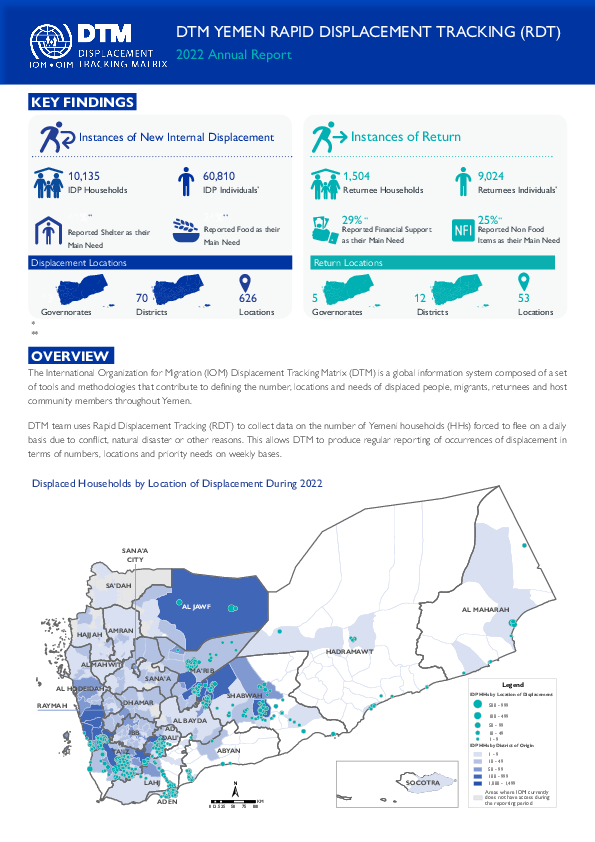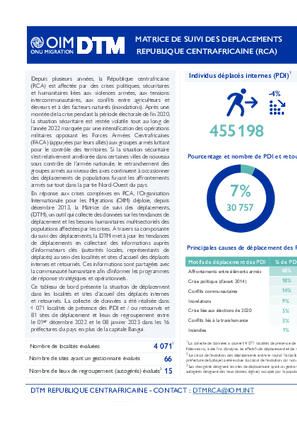-
Countries
-
Data and Analysis
-
Special Focus
-
Crisis Responses

Contact
DTM Support — iomdrcdtm@iom.int
Language
English
Location
Democratic Republic of the Congo
Period Covered
Jan 13 2023
Jan 31 2023
Activity
- Mobility Tracking
- Event Tracking
Depuis quelques mois, la République Démocratique du Congo, en particulier la province du Nord Kivu, est affectée par des crises sécuritaires et humanitaires liées au conflit armé entre les Forces Armées de la République Démocratique du Congo (FARDC) et le Mouvement du 23 mars (M23), qui a un impact considérable sur certaines zones, notamment les territoires de Rutshuru, Nyiragongo et récemment Masisi. Malgré une accalmie relative des hostilités à grande échelle au cours de la seconde moitié du mois de décembre 2022 et le retrait militaire du groupe de certaines zones contrôlées, notamment depuis les négociations régionaux des États d'Afrique de l'Est (EAS), les conflits ont continué à affecter les communautés et à provoquer de nouveaux déplacements dans la province (ETT # 108 et 109), notamment au cours du mois de janvier 2023.

Contact
DTM Yemen, iomyemendtm@iom.int
Language
English
Location
Yemen
Period Covered
Jan 01 2022
Dec 31 2022
Activity
- Rapid Emergency Registration
- Mobility Tracking
DTM team uses Rapid Displacement Tracking (RDT) to collect data on the number of Yemeni households (HHs) forced to flee on a daily basis due to conflict, natural disaster or other reasons. This allows DTM to produce regular reporting of occurrences of displacement in terms of numbers, locations and priority needs on weekly bases.
RDT methodology was used to track displacement events in terms of numbers of households of internally displaced persons (IDPs) between January and December 2022. The aim of this tool is to provide timely and actionable data on new population movements only and does not capture total numbers of IDPs in terms of population sizes.
DTM recorded 10,135 household displacements (representing approximately 60,810 IDPs) who fled mainly due to conflict (85%;8,620 HHs), followed by economic reasons related to conflict
(12%; 1,237 HHs) and natural disasters (3%; 276 HHs) in 2022. This data only represents displacement events that took place within the year and excludes any households displaced previously who remain in displacement or who have returned. With the exception of August, DTM did not record more than 1,000 households displaced per month as of April 2022 – a first since June 2021.
Displacement due to insecurity caused by conflict can be further split into combat and shelling (49% of total displacement) and general insecure conditions (36%). Among economic reasons linked to conflict, unemployment or salary cuts were the most frequently mentioned (7%). Rain and floods made up nearly all answers provided under the category of natural disaster (3%).
This document presents the resumption of migration from the coasts of West Africa to the Canary Islands (Spain). This route, already active in 2006, saw an increasing number of movements in 2022. The risks, deaths and disappearances following shipwrecks are also on the rise along the Atlantic coasts.
Between January and December 2022, 15,682 people reached the Canary Islands irregularly after crossing by boat from the coasts of West Africa, a decrease of 30%, or 6,634 people compared to 2021 (22,316). It is the first time since the increase in crossings was first recorded in 2019 that this number has fallen.
Nevertheless, risks and dangers along the West African Atlantic route remain and 45 shipwrecks were recorded along this route in 2022, resulting in the death or disappearance of 543 migrants.
This document presents the resumption of migration from the coasts of West Africa to the Canary Islands (Spain). This route, already active in 2006, saw an increasing number of movements in 2022. The risks, deaths and disappearances following shipwrecks are also on the rise along the Atlantic coasts.
Between January and December 2022, 15,682 people reached the Canary Islands irregularly after crossing by boat from the coasts of West Africa, a decrease of 30%, or 6,634 people compared to 2021 (22,316)(3). It is the first time since the increase in crossings was first recorded in 2019 that this number has fallen.
Nevertheless, risks and dangers along the West African Atlantic route remain and 45 shipwrecks were recorded along this route in 2022, resulting in the death or disappearance of 543 migrants.

Contact
Niger Migration Data and Research Unit - nigerdataresearch@iom.int
Language
English
Location
Niger
Period Covered
Aug 01 2022
Aug 31 2022
Activity
- Survey
The Tillaberi region in the Southwestern Niger has been facing growing insecurity since 2016 with an escalation of VEO (Violent Extremism Organization) attacks against soldiers, state officials and local leaders. Thousands of people from several departments in the region, were forced to move to flee the threats, ultimatums, and abuses of non-state armed groups (NSAG), to the towns.
The department of Kollo, which is one of the 13 departments of Tillaberi, has not yet reached dangerously high levels of VEO activity or recruitment, albeit it has experienced episodes of insecurity in some communes since 2021. Conducting a stability survey at this stage is an opportunity to implement preventive measures before a resurgence of VEO activities.
Therefore, the stability index in the department of Kollo will provide correct information not only to protect the lives and livelihoods of its citizens, but also to secure an essential economic route to the capital Niamey.
The Stability Index aims to determine the factors that influence the state of stability of a place, which can inform priority programmatic interventions along the humanitarian, peace, and development nexus, in order to build resilience and stability and prevent future forced displacements
This report presents the results of the stability index assessments in Kollo, in the Tillaberi region.

Contact
DTM République Centrafricaine, DTMRCA@iom.int
Language
English
Location
Central African Republic
Period Covered
Dec 01 2022
Jan 08 2023
Activity
- Mobility Tracking
- Baseline Assessment
Ce tableau de bord présente la situation de déplacement dans les localités et sites d’accueil des déplacés internes et retournés. La collecte de données a été réalisée dans 4 071 localités de présence des PDI et / ou retournés et 81 sites de déplacement et lieux de regroupement entre le 01er décembre 2022 et le 08 janvier 2023 dans les 16 préfectures du pays en plus de la capitale Bangui.

Contact
DTM Europe, DTMMedIM@iom.int
Language
English
Location
Serbia
Period Covered
Dec 08 2022
Dec 15 2022
Activity
- Survey
- Migrants presence
- Mobility Tracking
IOM, together with the Serbian Commissariat for Refugees and Migration (KRIS), carried our this customised survey of Moroccan nationals in Serbia from 8 to 15 December 2022. IOM interviewed 92 Moroccan nationals in six reception facilities across Serbia to better understand their demographic profiles as well as migration drivers and onwards intentions.

Contact
DTMUkraine@iom.int
Language
English
Location
Ukraine
Period Covered
Jan 01 2023
Jan 31 2023
Activity
- Mobility Tracking
- Baseline Assessment
The Registered IDP Area Baseline Assessment provides granular data on the number and geographic location of officially registered internally displaced persons (IDPs). Data collection for the Area Baseline assessment Round 20 took place between 1 and 31 January 2023 across 23 oblasts and Kyiv city. In the areas covered, the number of recorded IDPs was collected for all 107 raions and 967 hromadas (67% of all hromadas in the covered oblasts). In addition, gender disaggregated figures were provided across 47 per cent of hromadas.
Contact
DTMUkraine@iom.int
Location
Ukraine
Activity
- Mobility Tracking
- Baseline Assessment
Period Covered
Jan 01 2023 -Jan 31 2023
A baseline assessment is a sub-component of mobility tracking. It aims to collect data on IDP, migrant or returnee population presence in a defined administrative area of the country.
This is a restricted dataset. To get access, kindly click on the 'Request Access' button.
Population Groups
IDPs
Survey Methodology
Unit of Analysis Or Observation
Admin Area 2
Type of Survey or Assessment
Key Informant
Keywords
Geographical Scope Partial Coverage
Administrative boundaries with available data
The current dataset covers the following administrative boundaries


